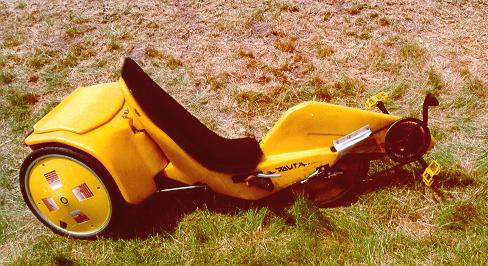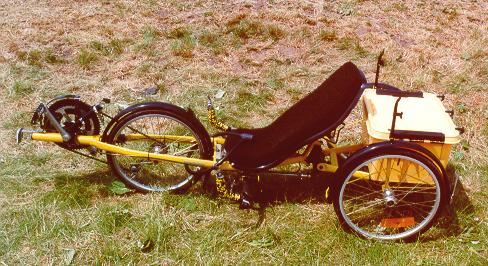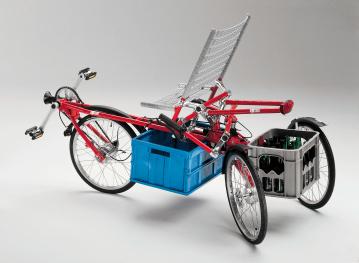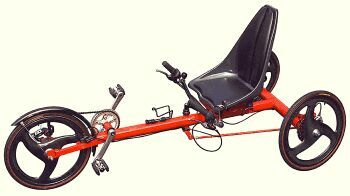Rear Wheel Steered Trikes

Rear Wheel Steered Trikes |

|
Here I give a summary of some rear wheel steered trikes (RWST's).
In case you can give me some remarks or corrections: Please
tell me!
| While rear wheel steering has not been really successful with bikes, it had more success with trikes. Several hobbyists have built one, and some have even been produced commercially. |
 At the end of the 19th century, many bicycle experiments were done.
A rear wheel steered tandem, built in 1890-1900, was the Pollard.
At the end of the 19th century, many bicycle experiments were done.
A rear wheel steered tandem, built in 1890-1900, was the Pollard.
Photo from British Cycling Museum, Camelford, Cornwall, UK
 The best known RWST's have been the Jouta trikes. They have been produced successfully for several years.
The best known RWST's have been the Jouta trikes. They have been produced successfully for several years.
It is easy to ride on them, thanks to a special patented tilt-steer system.
This system makes a tilt with every steering movement.
The disadvantage of this tilting system is that there is a fixed tilting angle for each steering angle.
It would be better as this would be speed-dependant (more tilting in the same corner at higher speeds).
This trike could be ridden very well, but at higher speeds it can be suddenly unstable.
That's one of the reasons why the production was finally stopped.
 The trike above is the Jouta SuperTrike. It was made of mould-shaped plastic.
The trike above is the Jouta SuperTrike. It was made of mould-shaped plastic.
The trike on the right is a later version, the Jouta VX. It was made of steel tubes, and had rear suspension.
More information about these trikes (in dutch, but with lots of well understandable pictures) can be found at the
site of Axel Belinfante.
 Exactly the same steering mechanism as the Jouta VX can be found in the 'Raven' of the American brand 'Just Two Bikes'.
Only the design is (in my opinion) ugly, and the price is much higher than the Jouta's price has ever been.
Exactly the same steering mechanism as the Jouta VX can be found in the 'Raven' of the American brand 'Just Two Bikes'.
Only the design is (in my opinion) ugly, and the price is much higher than the Jouta's price has ever been.
 In Germany, a rear wheel steered trike is produced with a tilting mechanism that is independant from steering angle:
The 'Culty'. On this trike, you can - as contrasted with the Jouta's -
have the correct tilting angle in every corner at every speed.
In Germany, a rear wheel steered trike is produced with a tilting mechanism that is independant from steering angle:
The 'Culty'. On this trike, you can - as contrasted with the Jouta's -
have the correct tilting angle in every corner at every speed.
In spite of that, it doesn't fall down at zero speed, because the parking brake blocks the tilting mechanism as well.
The seat angle is pretty upright (in order to get enough pressure on the driven front wheel) and it can transport much luggage.
At speeds > 30 km/h the steering seems to be not quite stable.
 Another German RWST in production is the German Soon WT3, produced by the
Schumacher company.
This robust trike has of course the well-known behaviour of all rear wheel steered vehicles, such as strong oversteered characteristic
and the unability to get away from pavements, cars, walls if it is too close.
Another German RWST in production is the German Soon WT3, produced by the
Schumacher company.
This robust trike has of course the well-known behaviour of all rear wheel steered vehicles, such as strong oversteered characteristic
and the unability to get away from pavements, cars, walls if it is too close.
If you don't ride it too fast, it can well be ridden.

 Yet another rear wheel steered trike is the Thebis.
Yet another rear wheel steered trike is the Thebis.
Bill Robinson, who has had one, wrote to me:
The Thebis was a magnesium framed, overly engineered trike with both rear wheel drive and rear wheel steering. It has been produced in Vancouver USA*,
and probably some hundreds have been produced in the 1980's. It was very delicate and extremely hard to repair since all the parts were custom machined.
Mine broke and broke until I couldn't fix it anymore. It remains one of the lightest trikes ever produced, but also possibly one of the more dangerous!
At speed it's hard to control, like many rear-steer trikes, and the center of mass is too high. It also cannot accomodate a motor assist.
*Erratum from Bob Stuart: It has been produced in Sidney, British Columbia, Canada, between the well-known Vancouver, Canada, and Victoria,
on Vancouver island.
Site of Bill Robinson
Site with more Thebis photo's
E-mail about Thebis repair from Paul Jarvis (Canada)
 There is also an American trike which is constructed just the opposite way:
The sidewinder.
This trike has two driven front wheels and one steering rear wheel.
There is also an American trike which is constructed just the opposite way:
The sidewinder.
This trike has two driven front wheels and one steering rear wheel.
This trike can be steered in two different ways: normally is directly to the rear fork,
but there is an additional option to remove the connection between handlebars and rear wheel.
Then, steering can be done by braking one of the two brakes (resp. on left and right driving axle).
I suppose the latter option is more for fun; NOT on the open road.
 There is even a children's trike with rear wheel steering, the Tiago. It has been designed and is produced by
Bram Smit.
More information can be found on the builder's site.
There is even a children's trike with rear wheel steering, the Tiago. It has been designed and is produced by
Bram Smit.
More information can be found on the builder's site.
 A last addition to this page is a 'trike' that has no rear wheels at all: A skate trike with rear skate steering.
It was built in the USA by Mark Stonich for an ice race in Minnesota.
A last addition to this page is a 'trike' that has no rear wheels at all: A skate trike with rear skate steering.
It was built in the USA by Mark Stonich for an ice race in Minnesota.
 I received a mail from Mr. Richard Olson, who got this RWST as a present from his father in 1942 (!).
I received a mail from Mr. Richard Olson, who got this RWST as a present from his father in 1942 (!).
It looked in every sense like a conventional trike. However, it had a rod running from the handlebars, beneath the seat, to a steering mechanism between the rear wheels. Steering was accomplished by rolling the handlebars - left side down to turn left, etc.
It should have been a production model, as he got it in a box and assembled it together with his father.
Here he is riding it with his little sister.
Richard likes to know if anyone can tell him more about this trike. Name, producer, place and so on.
If you know more about it: Please send a mail to Richard Olson.
|
Back to the RWSB page To RWSB page part 2 To homepage of this recumbent bike site |
Erik Wannee / last update: 2009-01-02 |